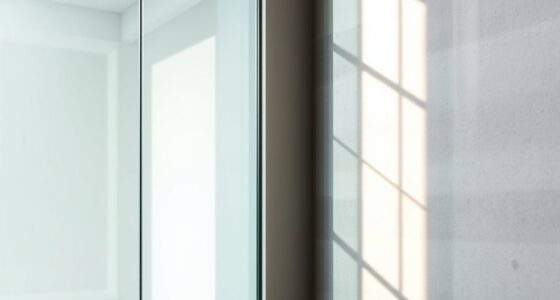When choosing between glass and solid walls, don’t fall for myths that glass always means less privacy or weaker durability. In reality, privacy depends on design and materials, like frosted or tinted glass, and solid walls usually offer better soundproofing and impact resistance. Appearance and energy efficiency vary based on style and insulation options. To make the best decision, consider your specific needs for privacy, durability, and flexibility—there’s more to uncover if you keep exploring.
Key Takeaways
- Transparency doesn’t necessarily compromise privacy; decorative glass options can enhance privacy while maintaining openness.
- Glass walls improve natural light and aesthetic appeal but often offer less soundproofing than solid walls.
- Solid walls typically provide higher durability, impact resistance, and better thermal and fire insulation than glass.
- Initial costs for glass walls are higher, but they offer greater flexibility and easier interior reconfiguration.
- Material choice impacts long-term maintenance: solid walls require less upkeep, while glass needs regular cleaning and potential repairs.
Common Misconceptions About Transparency and Opacity
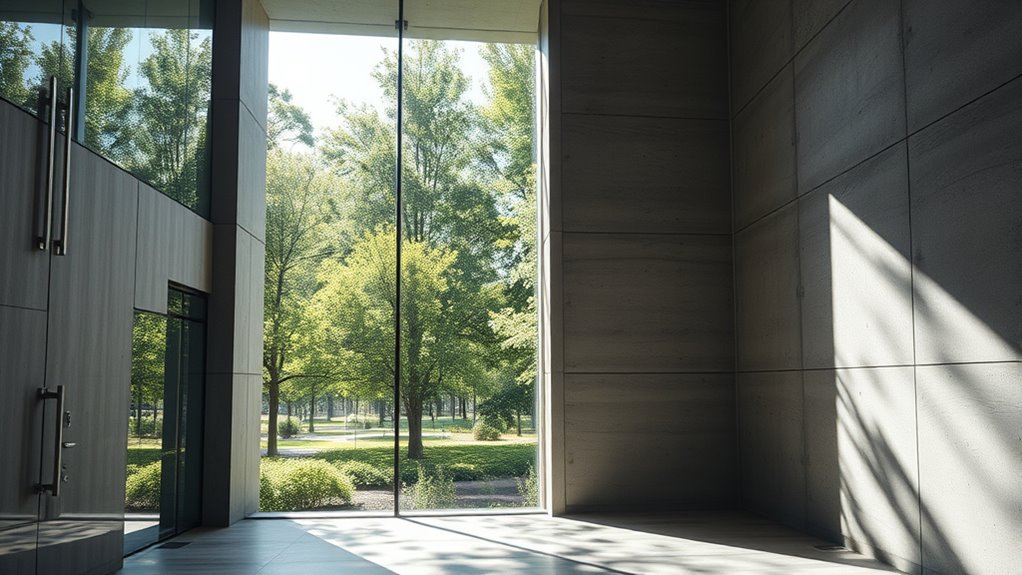
Many people assume that transparency and opacity are simply opposites, but in reality, the concepts are more nuanced. One common transparency misconception is that clear glass automatically means less privacy. However, transparency isn’t always about visibility; it can involve understanding or openness without sacrificing privacy. Privacy concerns often drive debates about transparency, but sometimes these worries are overestimated. For example, a glass wall might be transparent, but privacy can still be maintained through design choices like frosted sections or smart tinting. Recognizing these nuances helps you avoid oversimplifying the debate. It’s essential to understand that transparency can coexist with privacy, and opacity doesn’t necessarily mean complete seclusion. Clarifying these misconceptions allows for more informed decisions about when and where transparency truly matters.
How Privacy Really Differs Between Glass and Solid Walls
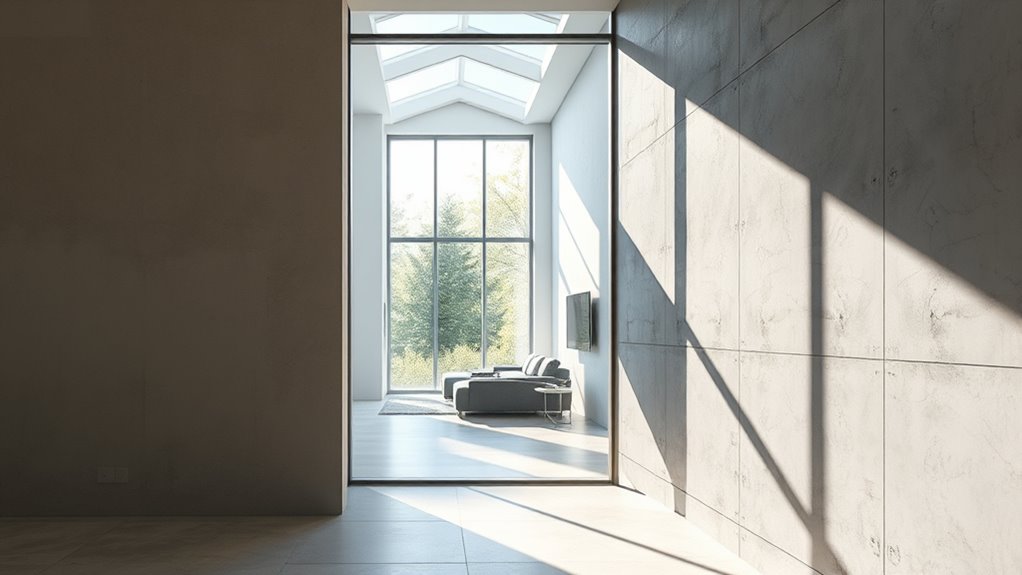
While glass walls often appear more open and transparent, they don’t automatically mean less privacy. Your privacy perception depends on factors beyond visibility, like how sound travels through the material. Glass can be surprisingly effective at providing visual privacy if frosted or tinted, but it may still compromise noise isolation. Solid walls, on the other hand, generally block sound better, creating a more secluded environment. This difference impacts your sense of privacy, especially in shared spaces or offices where noise and visibility matter. Keep in mind that privacy isn’t just about seeing or being seen; it’s also about hearing and being heard. So, choosing between glass and solid walls involves considering both visual openness and acoustic privacy, not just appearance. Additionally, understanding the contrast ratio of the materials can help determine how well sound and light are contained, influencing overall privacy levels.
The Impact of Material Choices on Acoustic Performance
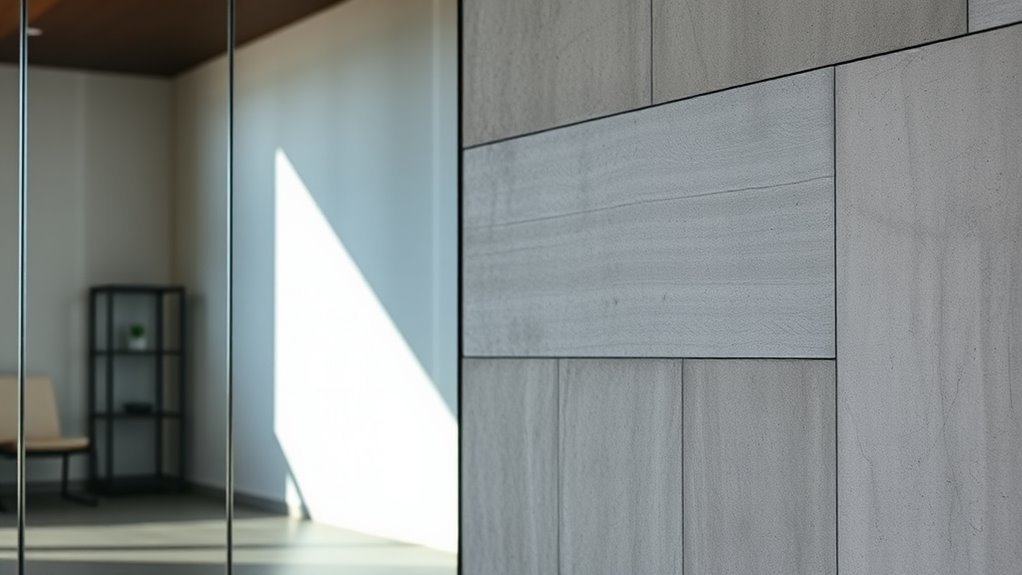
Your choice of materials directly affects how sound travels through a space. Thicker, denser materials tend to block more noise, while lighter ones allow sound to pass more easily. Considering these factors helps you select walls that meet your acoustic needs effectively. Additionally, understanding the soundproofing capabilities of different materials can further enhance the acoustic performance of your space.
Sound Transmission Differences
Have you ever wondered how the choice between glass and solid walls affects sound transmission? The key factor is sound insulation, which directly influences acoustic performance. Solid walls, especially those made of dense materials like concrete or brick, generally provide superior sound insulation by blocking more noise from passing through. Glass walls, on the other hand, tend to transmit sound more easily, which can be a disadvantage in noisy environments. However, modern acoustic glass options can improve sound insulation notably. Your choice impacts how well sound is contained or transmitted between spaces. If you need privacy or noise control, solid walls are typically more effective. But for open, bright spaces where light transmission matters, glass may still be suitable, with some compromises on acoustic performance. Advances in building materials continue to enhance the soundproofing capabilities of glass, narrowing the gap with traditional solid walls.
Material Density Effects
Material density plays an essential role in determining a wall’s acoustic performance because denser materials generally block sound more effectively. When choosing between glass and solid walls, weight considerations become critical since higher material density means increased mass, which helps reduce sound transmission. Denser materials absorb and reflect sound waves better, making them ideal for noise control. For example, solid walls with high material density can considerably dampen noise compared to lighter, less dense options. However, keep in mind that increased weight can impact structural requirements and installation costs. Balancing material density with practical weight considerations ensures you optimize acoustic performance without overburdening your building’s framework. Understanding how pimple patches work and their role in skin healing can also inform your choices in building design, especially when considering materials that influence environmental comfort. Ultimately, understanding how material density influences sound blocking helps you make more informed decisions about wall construction.
Aesthetics and Visual Appeal: Debunking Style Myths

Many believe that glass walls only suit modern spaces, but they actually offer versatile style options that can complement various designs. Their sleek, contemporary look creates a light and spacious feel that enhances any room. Don’t assume style limitations—glass can be customized to fit your aesthetic preferences. For example, incorporating rustic elements alongside glass walls can beautifully blend farmhouse charm with modern transparency, resulting in a unique and inviting space.
Modern, Sleek Looks
Despite common misconceptions, glass walls are far from sacrificing style for function; in fact, they often define modern, sleek aesthetics that appeal to contemporary tastes. They draw inspiration from historical architecture, where transparency and openness symbolized progress and enlightenment. Today, glass designs emphasize minimalism and clean lines, aligning with current trends toward simplicity and sophistication. This approach also challenges cultural symbolism tied to solid walls as barriers, instead promoting a seamless flow between spaces. The sleek appearance of glass fosters a sense of openness, making interiors look more expansive and refined. By blending form and function, glass walls create a timeless, stylish statement that resonates with modern design principles, proving that aesthetics can be elevated without compromising practicality. Additionally, innovations in building materials have enhanced the durability and safety of glass installations, further solidifying their place in contemporary architecture.
Light & Spacious Feel
Glass walls don’t just look sleek—they also transform how a space feels. They maximize natural light and create an open, airy environment that feels more spacious. With the right decorative finishes, you can enhance this effect, making your space appear even larger and more inviting. Lighting effects play a vital role; they bounce off glass surfaces, illuminating every corner without cluttering the view. To illustrate, consider the table below:
| Effect | Benefits | Best Use |
|---|---|---|
| Natural light | Brightens space, reduces need for artificial lighting | Living rooms, offices |
| Reflective surfaces | Adds visual depth, enlarges perceived space | Open-plan areas, kitchens |
| Decorative finishes | Personalizes style, softens transparency | Accent walls, partitions |
This combination creates a luminous, spacious ambiance that solid walls can’t easily match. For example, incorporating decorative finishes can soften the transparency of glass and tailor the aesthetic to your preferences, further enhancing the spacious feel.
Style Compatibility Options
Some people assume that glass walls only suit modern, minimalist spaces, but in reality, they can seamlessly blend with a variety of design styles. You can enhance their visual appeal with decorative patterns, such as etched or frosted designs, adding texture and personality. Color options also expand style possibilities; tinted or colored glass can complement vibrant or subdued palettes, creating a unique atmosphere. Whether you prefer sleek, industrial looks or warm, traditional interiors, glass walls can adapt through these decorative elements. This versatility allows you to customize your space, debunking the myth that glass is limited to certain aesthetics. Additionally, understanding how environmental considerations influence design choices can help you select sustainable and eco-friendly options. Ultimately, with thoughtful choices in patterns and colors, glass walls become a stylish, functional feature that enhances your home’s overall design.
Structural Strength and Durability: What You Need to Know

When evaluating structural strength and durability, it’s important to recognize that solid walls typically offer greater resistance to impacts and environmental stresses than glass walls. Solid walls generally provide better thermal insulation and fire resistance, making them more suitable for safety-critical areas. Glass walls can be vulnerable to breakage and may require reinforcement for enhanced durability. Here’s a quick comparison:
| Aspect | Solid Walls | Glass Walls |
|---|---|---|
| Impact Resistance | High | Moderate to low |
| Thermal Insulation | Superior | Limited |
| Fire Resistance | Better | Limited |
| Durability | Long-lasting with proper materials | May need reinforcement |
Additionally, understanding structural integrity is crucial when choosing between these options to ensure safety and longevity.
Maintenance and Long-Term Upkeep Considerations

Maintaining your walls over time requires careful attention to durability and repair needs. Glass walls may need frequent cleaning to stay clear, while solid walls might require repairs from wear and tear. Consider how much effort you’ll invest in cleaning and upkeep to keep your space looking its best. Additionally, understanding soulmate angel numbers can guide you in recognizing signs of evolving relationships and emotional harmony, influencing how you prioritize your home environment.
Durability and Repairs
While both glass and solid walls require regular upkeep, their durability and repair needs differ significantly over time. Glass walls are more prone to cracking and shattering, often needing prompt repairs to prevent further damage, especially in high-traffic areas. Solid walls, made from materials like brick or concrete, generally withstand impact better, but may develop cracks or surface wear that require patching or repainting. In terms of thermal insulation, solid walls typically provide better long-term energy efficiency, reducing heating and cooling costs. Repairs to solid walls are usually less frequent but can be more labor-intensive. When considering environmental impact, repairing and maintaining glass walls can involve replacing panes, which may have a higher ecological footprint, whereas solid walls tend to be more durable and easier to maintain over time.
Cleaning and Upkeep
Glass walls require regular cleaning to maintain their clarity and appearance, often involving streak-free glass cleaners and careful wiping to prevent smudges and water spots. Your cleaning routines should be consistent, using soft cloths and gentle solutions to avoid scratches. While cleaning glass can be straightforward, it’s essential to stay vigilant against fingerprints and mineral deposits that can dull the surface. In contrast, solid walls generally need less frequent upkeep, mainly involving dusting and occasional repainting. When considering long-term maintenance, keep in mind that glass walls can incur higher upkeep costs due to the need for specialized cleaners and more frequent cleaning. Proper upkeep guarantees your glass walls stay pristine, but it’s important to weigh these ongoing efforts against their aesthetic benefits.
Energy Efficiency: Separating Fact From Fiction
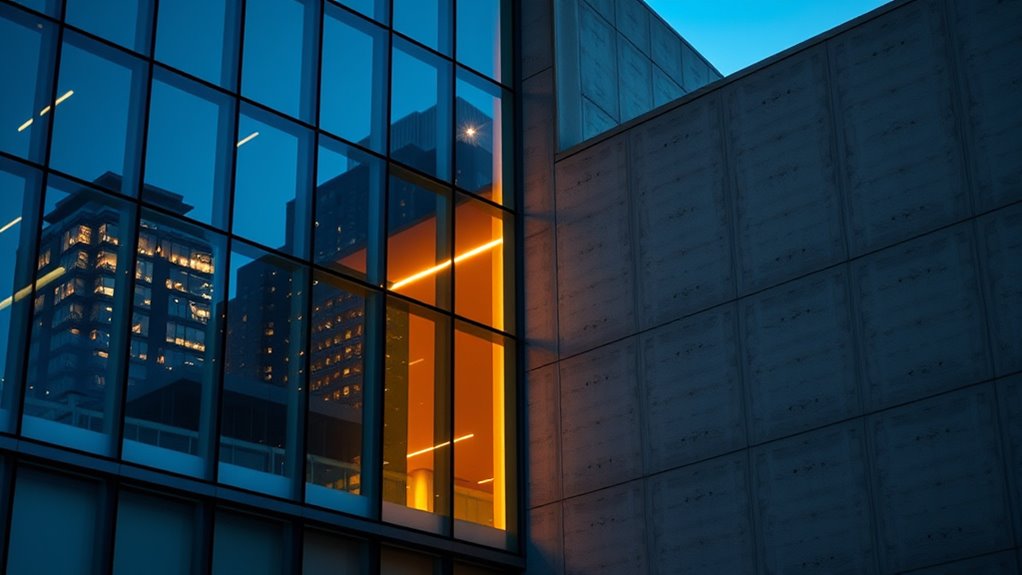
Many believe that glass walls automatically lead to higher energy costs because they let in more heat or cold. However, this isn’t always true. Modern glass walls often feature advanced thermal insulation, which helps maintain consistent indoor temperatures. Proper installation and the use of double or triple-glazed panels considerably reduce heat transfer. Additionally, soundproofing techniques can improve overall energy efficiency by preventing drafts and air leaks around the glass. It’s a misconception that solid walls always outperform glass in energy efficiency; the key lies in the materials and design. When chosen wisely, glass walls can be just as energy-efficient as solid walls, especially with proper insulation and sealing. So, don’t dismiss glass walls based solely on energy concerns—they can be a smart, efficient choice.
Cost Implications of Installing Glass Versus Solid Walls

Installing glass walls often requires a higher upfront investment compared to solid walls, primarily due to the cost of specialized materials and advanced framing systems. When doing a cost analysis, you’ll notice glass options typically come with premium prices for materials and installation. Budget considerations are vital, as initial costs can influence your decision considerably. Here’s a quick comparison:
| Aspect | Glass Walls | Solid Walls |
|---|---|---|
| Material Cost | Higher | Lower |
| Installation Complexity | More advanced, specialized labor | Standard labor |
| Maintenance Expenses | Potentially higher over time | Generally lower |
| Energy Savings Impact | Can be significant, reducing costs | Usually minimal |
| Overall Investment | Higher | More budget-friendly |
Understanding these factors helps you balance aesthetics with your financial plan.
Flexibility and Adaptability in Interior Layouts

Choosing between glass and solid walls can considerably impact how flexible and adaptable your interior spaces are. Glass walls offer ease of reconfiguration, allowing you to open up or close off areas quickly, which enhances versatility. However, privacy concerns may arise if transparency isn’t managed properly, and acoustic insulation can be limited, making noise control challenging. Solid walls provide more permanent separation and better soundproofing, ensuring privacy and reducing disruptions. While they’re less adaptable for frequent layout changes, they give you more control over privacy and noise levels. Ultimately, your choice depends on your need for flexibility versus privacy and acoustic performance. If you prioritize easy reconfiguration, glass might be better; if privacy and soundproofing matter most, solid walls are usually the way to go.
When to Prioritize Functionality Over Aesthetics
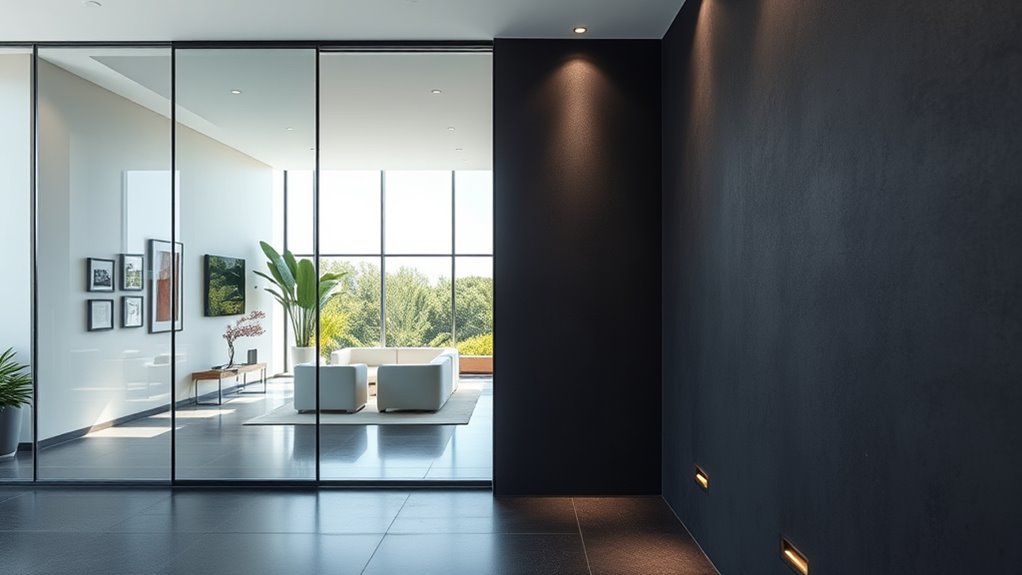
Have you ever had to decide between a space that looks great and one that functions flawlessly? Prioritizing functionality over aesthetics becomes essential when privacy concerns are high. Glass walls, while sleek, may compromise confidentiality or create noise issues, making solid walls a better choice. Similarly, installation challenges can influence this decision; complex glass setups might be costly and difficult to install securely. If your space requires soundproofing, durability, or strict privacy, opting for solid walls ensures reliable performance. Aesthetics are important, but when your primary need is a practical, secure environment, functionality should take precedence. Recognizing these factors helps you make informed choices, ensuring your space meets both your privacy needs and operational demands without unnecessary compromises.
Frequently Asked Questions
How Do Glass and Solid Walls Influence Natural Light Distribution?
Glass walls let in more natural light, brightening your space and making rooms feel larger, but they can raise privacy concerns and reduce sound insulation. Solid walls block light, creating darker environments, but offer better privacy and soundproofing. Your choice impacts how light spreads and how much sound travels between areas. Consider your needs for natural illumination versus privacy and sound control when deciding between glass and solid walls.
What Are the Environmental Impacts of Choosing Glass Over Solid Walls?
Choosing glass over solid walls impacts the environment mainly through recyclability concerns and manufacturing energy consumption. Glass is highly recyclable, reducing waste, but its production consumes significant energy, contributing to carbon emissions. Solid walls, often made from less energy-intensive materials, have a smaller carbon footprint during construction. Your decision should balance recyclability benefits with the environmental costs of manufacturing, aiming for options that promote sustainability and energy efficiency.
Can Glass Walls Improve Overall Workspace Productivity?
Glass walls can boost your workspace productivity by enhancing acoustic performance and aesthetic appeal. They allow natural light to flow, reducing eye strain and creating a more inviting environment. Plus, the transparency encourages collaboration and openness, making it easier to communicate with colleagues. Overall, choosing glass walls helps foster a positive, energetic atmosphere that can lead to increased focus and efficiency throughout your workday.
Are There Any Health Concerns Associated With Glass Wall Materials?
You might be glad to know that glass walls are generally safe, but be aware that some materials can cause health concerns. For example, 15% of glass panels emit low levels of chemical emissions, and prolonged ultraviolet exposure can lead to eye strain or skin issues. To stay safe, choose glass with UV protection and low-emission coatings, ensuring a healthy workspace without sacrificing style or transparency.
How Do Installation Times Compare Between Glass and Solid Wall Options?
You’ll find that installation speed for glass walls is generally quicker than solid walls because they’re prefabricated and easier to assemble. This means shorter construction durations, reducing overall project timelines. Solid walls often require more time due to framing, insulation, and finishing work. So, if speed matters for your project, glass walls can offer a significant advantage by streamlining installation and minimizing disruption.
Conclusion
Ultimately, choosing between glass and solid walls isn’t about finding a perfect solution but about discovering what feels right for your space. Think of it as fine-tuning a melody—you’ll find the harmony when you consider all the nuances, from privacy to aesthetics. Trust your instincts and enjoy the process of shaping a space that truly resonates with your style and needs. After all, your environment should reflect what makes you feel most at home.





